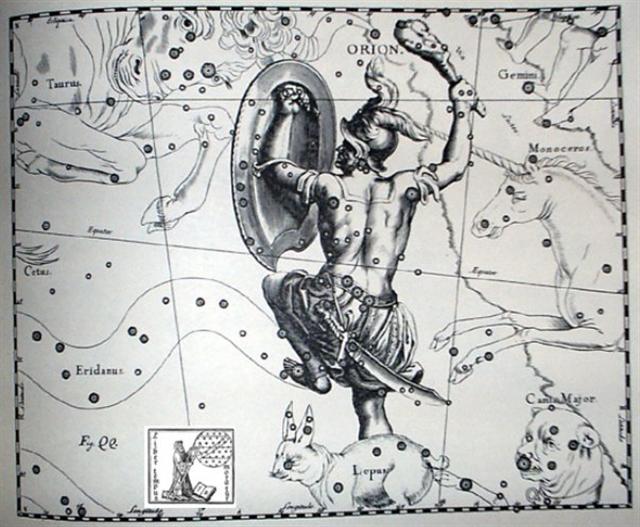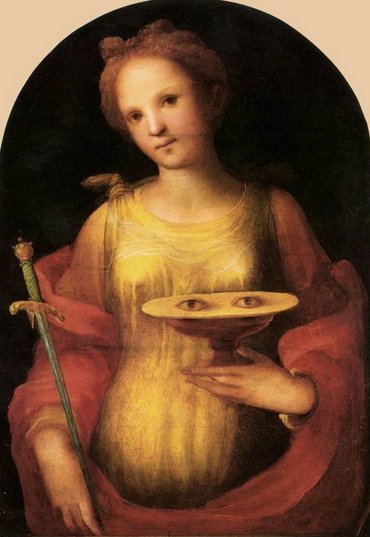There should be a glyph for heliacal Heka also on side a. With Ca1-1 at September 20 we can count 365 + 163 (June 12) - 263 (September 20) = 265 days (glyphs) ahead from the beginning of the text:
In Ca10-11 there is possibly a White Spot where the eye of manu rere should be. And the pointed beak could serve as a tara (point in time). The front wing and tail is drawn down and no light can enter. The name of the star Heavenly Gate (ζ Tauri, at the tip of the southern - toga - horn) could have inspired the hole in Ca10-12. Cb10-9 has an upstretched empty hand - no light remains. Counting 'feathers' at left (in the past) we will find 14 + 13 = 27 (including Cb10-10). There is no hole in Cb10-10, on the contrary, and I have therefore tried with another star than Heavenly Gate.
The very faint (5.28) star ν is embedded somewhere in the tail of the Dove, which could be another sign of how very little light remained of the old year. June was named Maro on Easter Island and in this month the poultry had developed a lot of feathers. The eye (η) of the Dove rose together with Sun in June 19 (a Sun number). There may have been 8 dark nights from the White (Blind) Eye of Heka to the June solstice:
Glyph 274 (= 2 * 137) marks the June solstice. Possibly the evil influence from heliacal Heka ends here, similar to how after 8 dark Venus nights she will return with her light. Also π Columbae is very faint (5.50). This star was according to Hevelius positioned at the forehead of the diving Dove (although not visible). As to ξ Orionis, the very last star in the constellation, it is where the Blind Giant has his right wrist:
According to myth Orion was blind and this idea could have been founded on the White Spot (the unlucky Heka cooking tripod) inside which the Full Moon could be housed (hidden from view). The Moon is personified by Lepus and the right straight leg of Orion is at her back side. "Cataract is derived from the Latin cataracta, meaning 'waterfall', and from the Ancient Greek καταρράκτης (katarrhaktēs), 'down-rushing, from καταράσσω (katarassō) meaning 'to dash down' (from kata-, 'down'; arassein, 'to strike, dash'). As rapidly running water turns white, so the term may have been used metaphorically to describe the similar appearance of mature ocular opacities. In Latin, cataracta had the alternative meaning 'portcullis' and the name possibly passed through French to form the English meaning 'eye disease' (early 15th century), on the notion of 'obstruction'. Early Persian physicians called the term nazul-i-ah, or 'descent of the water' - vulgarised into waterfall disease or cataract - believing such blindness to be caused by an outpouring of corrupt humour into the eye." (Wikipedia) I think other explanations are more plausible. For instance did the 'Deer / Stag Head' (Heka) nakshatra end after 5 days with the heliacal rising of Betelgeuze in June 17 (168). Betelgeuze (α Orionis) is at the opposite corner of the constellation compared to Rigel. Betelgeuze ruled the Ardra (the Moist One) nakshatra. At the brink of the Milky white Waterway the Sun star became moist because at this time of the year all the moisture which had evaporated from Earth by the rays from the Spring Sun would have accumulated in rainclouds (which would hide not only Sun and Moon but also the stars):
The pair of manu rere with white round patches where their eyes should have shone are probably not Sun birds. The distance between them is not 5 days but 8 (a sign of Moon). Their beaks are pointed and growing, meaning the influence of Moon was waxing because that of Sun had evaporated. We should remember St Lucia who offered her pair of eyes on a tray:
In the night of December 13 and ideally close to the Full Moon was Heka. By the way, the Mayan 3 stones resting on the turtle have rainclouds drawn on them:
I have concluded this from the same kind of signs on the glyphs for the Mayan months beyond midsummer (Mol):
The colours may have been meant to illustrate the effects when light is encountering water droplets (creating rainbows). Black and white could then be explained as a way to say that in the night there are no rainbows. | ||||||||||||||||||||||||||||||||||||||||||||||||||||||||||||||||||||||||||||||||||||||||||||||||||||||||||||||||||||||||||||||||||||||||||||||||||||||||||





















